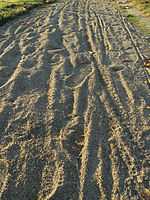Decomposed granite

Decomposed granite, also known as DG, is granitic rock that has weathered to the point that it readily fractures into smaller pieces or chunks of weak rock. Further weathering produces rock that easily crumbles into mixtures of gravel, sand, and silt-sized particles with some clay. Eventually, the gravel-sized particles may break down to produce a mixture of silica sand or silt particles and clay.
Composition
Granite is composed of plagioclase feldspar, orthoclase feldspar, quartz, mica and possibly other minerals. The chemical transformation of feldspar, one of the primary constituents of granite, into the clay mineral kaolin is one of the important weathering processes. The presence of clay allows water to seep in and further weaken the parent rock allowing it to fracture or crumble into smaller particles. Grains of silica in the granite are relatively resistant to weathering and may remain almost unaltered.[1]
Pavement

Decomposed granite, in a crushed stone form, is used as a pavement building material. It is used on driveways, garden walkways, bocce courts and pétanque terrains,and municipal urban park and natural regional and national park 'sidewalks' and heavy-use paths. It can be installed and compacted to meet handicapped accessibility specifications and criteria, such as the ADA standards in the U.S. Different colors, in natural ranges depending on quarry source, and polymeric stabilizer add-mixtures are available.
See also
- Crushed rock
- Chipseal
References
- ↑ Mitchell, J.K., and Soga, K. (2005) Fundamentals of soil behavior, Third edition, John Wiley and Sons, Inc., ISBN 978-0-471-46302-3, pages 200-204.